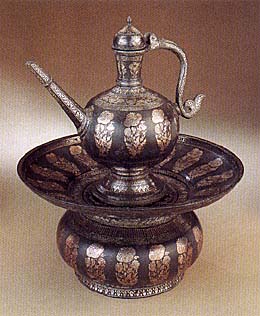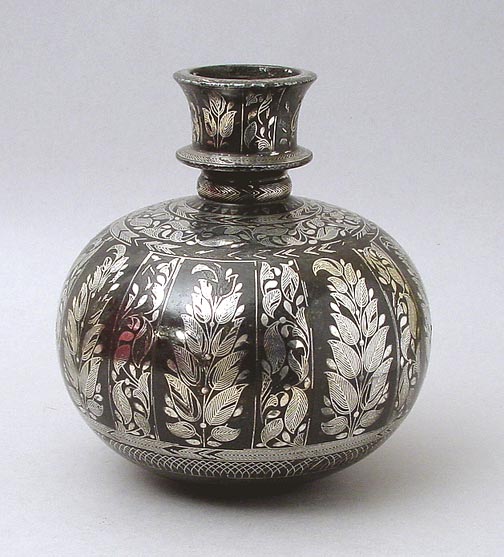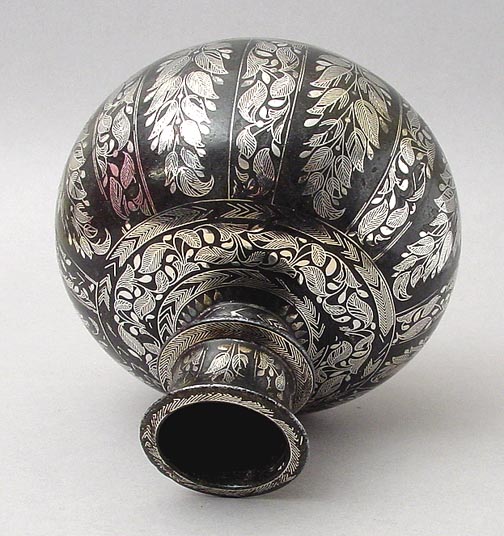

Ewer and basin of bidri ware, Deccan, 18th century
Source: http://www.worcesterart.org/Collection/Indian/1989.163.1-3.html
(downloaded Dec. 1999)
"Indian (Deccan) Ewer and Basin, 18th century. Bidri ware (cast metal alloy of zinc, copper, and lead with silver inlay). Islamic Rug Deaccessioning Fund, 1989.163.1-3. From the collection of the Worcester Art Museum.
The arts that flourished in the independent kingdoms of the Deccan derived
their inspiration not only from the Mughal empire--North India, Persia,
and West Asia--but from local traditions as well. Among such objects that
display originality in both design and technique is bidri ware, whose earliest
craftsmen were probably Persians patronized by the ruler of the Deccan
in the fifteenth century. As the descendants of the original Persian artisans
became Indian, local Muslims and some Hindus joined the bidri industry.
Composed of a uniquely Indian metal alloy inlaid with silver and then coated
to create a permanent black surface, bidri ware was made in a great variety
of shapes and sizes, including trays, cups, huqqa (water-pipe) bases, ewers,
and wash basins."


A bidriware huqqa base, probably from the Deccan, 17th-18th century
Source: ebay, Oct. 2002
"GOOD SILVER INLAID HUQQA, INDIA, 17TH ~ 18TH CENTURY. An Indian silver inlaid bidri huqqa bottle of squat globular form, decorated with panels of flowers within geometric and foliate patterned borders. In his book "Gold, Silver and Bronze from Mughal India", Mark Zebrowski illustrates many similar bidri huqqa bases, the globular form dating to the 17th century and into the early 18th century. Mostly he places them in the Deccan, the vast plain of central India. Collectors of Mughal metalwork, especially bidri ware, will know just how difficult these early pieces are to obtain. 6.1/4" high, 5.1/2" diameter."

Bidriware ewer
Source: ebay, Apr. 2004
"Bought from an estate sale. The vase is 10-1/2" tall and 6" across the widest area."

A bidri huqqah-base with brass and silver inlay work
Source: http://www.christies.com/LotFinder/search/LotDetail.asp?sid=&intObjectID=4483544&SE=CMWCAT04+629785+1886051328+&QR=M+1+23+Aqc0000900+611912++Aqc0000900+&entry=india&SU=1&RQ=True&AN=24
(downloaded Apr. 2005)
"A BIDRI BRASS AND SILVER INLAID SPHERICAL HOOKAH BASE, BIDAR, DECCAN, CENTRAL INDIA, LATE 17TH OR EARLY 18TH CENTURY. With cylindrical mouth, the sides with a broad band of large alternating inlaid irises and narcissi, arcaded band below, meandering floral and pendant bands on the shoulder, the mouth with a similar meandering floral tendril, slight damage to inlay, one area of restoration, base with later copper disc. 7 5/8in. (19.5cm.) high."
A vase from the official website of Bidar district, near Hyderabad
Source: http://bidar.nic.in/art.htm
(downloaded May 2006)
== Glossary index == map index == Indian Routes == fwp's main page ==